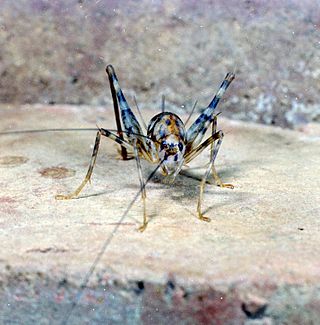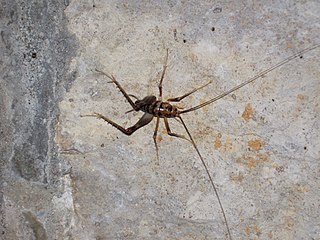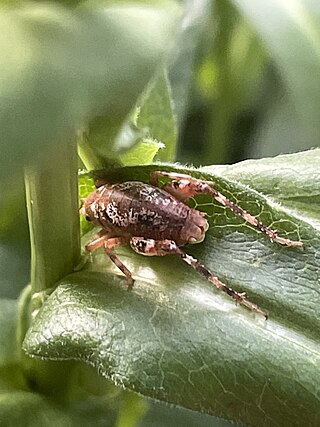
The orthopteran family Rhaphidophoridae of the suborder Ensifera has a worldwide distribution. Common names for these insects include cave crickets, camel crickets, spider crickets, and sand treaders. Those occurring in New Zealand are typically referred to as jumping or cave wētā. Most are found in forest environments or within caves, animal burrows, cellars, under stones, or in wood or similar environments. All species are flightless and nocturnal, usually with long antennae and legs. More than 500 species of Rhaphidophoridae are described.

Hadenoecus is a genus of common cave cricket of the southeastern United States and typical of the tribe Hadenoecini.

Ceuthophilus is a genus of insects in the cave cricket family Rhaphidophoridae. It contains most of the species that are known commonly as camel crickets.
Ceuthophilus californianus is a species in the family Rhaphidophoridae, in the order Orthoptera. The species is known generally as the "California camel cricket". It is found in North America.
Ceuthophilus utahensis, the Utah camel cricket, is a species of camel crickets in the family Rhaphidophoridae. It is found in North America.
Ceuthophilus divergens, the divergent camel cricket, is a species of camel crickets in the family Rhaphidophoridae. It is found in North America.
Ceuthophilus alpinus is a species of camel crickets in the family Rhaphidophoridae. It is found in North America.
Ceuthophilus guttulosus, or Thomas' camel cricket, is a species of camel cricket in the family Rhaphidophoridae. It was described by Francis Walker in 1869 and is found in North America.
Ceuthophilus latens, the black-sided camel cricket, is a species of camel cricket in the family Rhaphidophoridae. It is found in North America.
Ceuthophilus caudelli is a species of camel cricket in the family Rhaphidophoridae. It is found in southwest North America.
Euhadenoecus puteanus, the puteanus camel cricket, is a species of camel cricket in the family Rhaphidophoridae. It is found in North America.
Ceuthophilus chiricahuae, the chiricahua cave cricket, is a species of camel cricket in the family Rhaphidophoridae. It is found in North America.

Ceuthophilus stygius, known generally as the Kentucky cave cricket or cave camel cricket, is a species of camel cricket in the family Rhaphidophoridae. It is found in North America.

Hadenoecus subterraneus, the common cave cricket, or Mammoth Cave cricket is a species of camel cricket in the family Rhaphidophoridae. It is found in North America.

Gammarotettix is a North American genus of camel crickets in the family Rhaphidophoridae. They are also called chaparral camel crickets or arboreal camel crickets and are between 10–18 mm. They live mainly in California and possibly in southern Oregon and Arizona.
Styracosceles is a genus of camel crickets in the family Rhaphidophoridae. There are at least four described species in Styracosceles.
Euhadenoecus insolitus, the mccluney cave cricket, is a species of camel cricket in the family Rhaphidophoridae. It is found in North America. E. insolitus regularly forage outside their cave habitat except in the winter. Different populations reproduce either through sexual reproduction or parthenogenesis.
Hadenoecus cumberlandicus, the Cumberland cave cricket, is a species of camel cricket in the family Rhaphidophoridae. It is found in North America.
Hadenoecus opilionides, the Tennessee cave cricket, is a species of camel cricket in the family Rhaphidophoridae. It is found in North America.

Hadenoecini is a tribe of cave crickets in the family Rhaphidophoridae. There are two genera and nine described species. It is sometimes considered a synonym of the subfamily Dolichopodainae.




